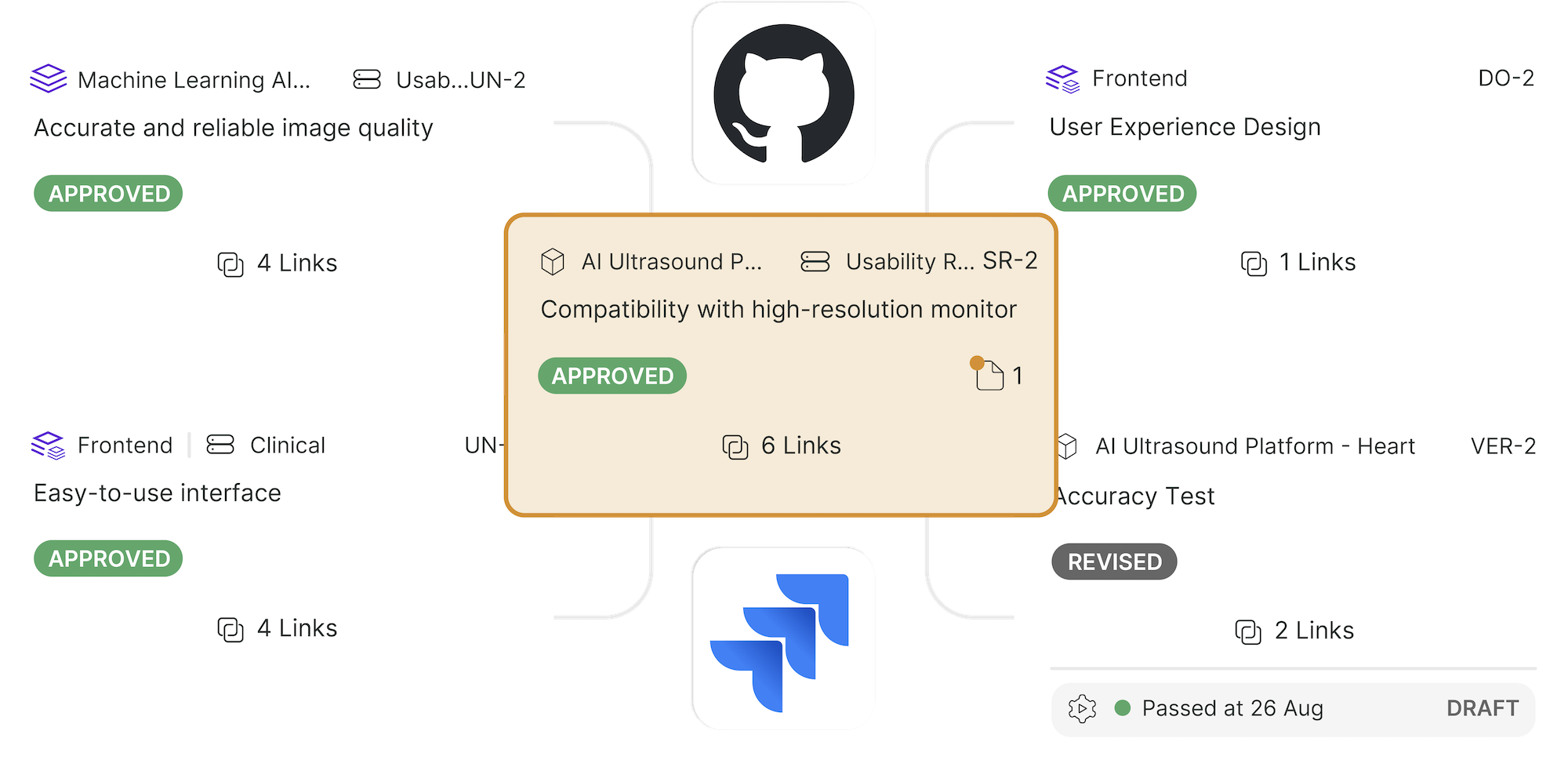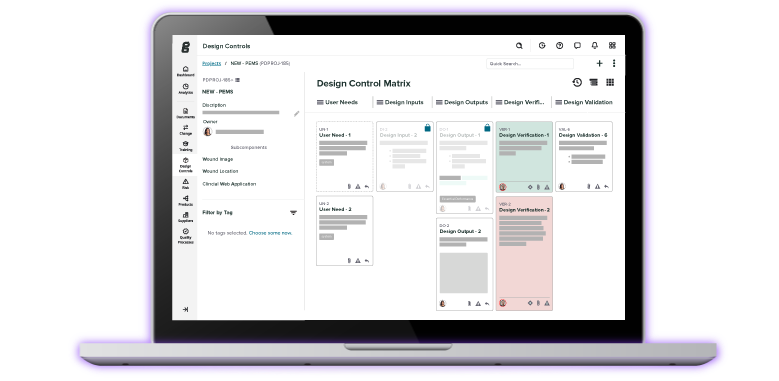5 Dos and Don'ts when Choosing a QMS Solution for Your Medical Device Company
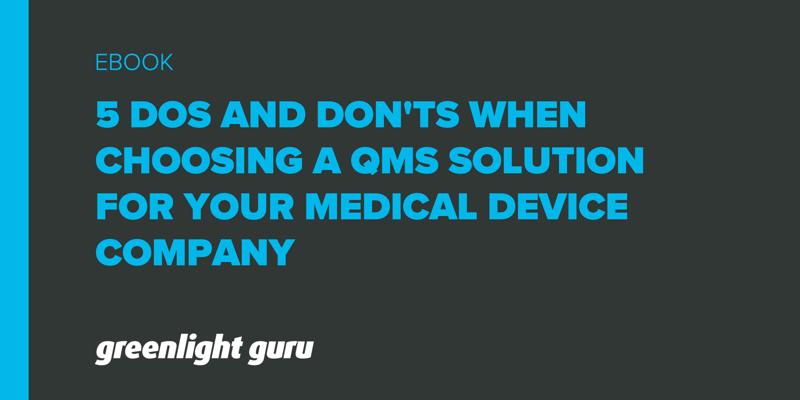
As a medical device manufacturer, your quality management system (QMS) is the heart of your operations.
A QMS contains everything that both internal teams and regulators need to know in order to get a product to market that achieves its intended purpose of delivering better outcomes to clinicians and patients. Your choice of a QMS will resonate throughout your product’s lifecycle.
While there is no one-size-fits-all QMS structure, there are a number of best practices (dos and don’ts) that medical device companies should keep top of mind when choosing a quality management solution. In this guide, we'll cover the top five decisions that have the biggest impact on your QMS—and your ability to get a device to market.
1. Account for medical device regulatory requirements
The regulatory process for medical devices is understandably stringent. Regulatory bodies have the important task of making sure every device on the market is safe and effective for its end users.
For your device to join those ranks, you’ll need to identify which regulatory requirements will apply and incorporate those processes into your QMS to assure compliance. This should be an ongoing consideration throughout the entire lifecycle of your medical device.
Do: Determine the applicable regulations for your medical device
There are many different regulatory requirements that may apply to your medical device depending on the market where you sell your device. Some regulatory standards are specific to certain markets, while others hold equal weight in multiple regions around the world.
Devices entering the US market need to meet FDA regulations under 21 CFR Part 820, while medical devices sold in the EU market must adhere to the new medical device regulations under MDR.
Industry standards, like ISO 13485:2016 (QMS requirements for medical devices) and ISO 14971:2019 (risk management for medical devices), are recognized in markets around the world. Although they are not governmental regulations, regulatory bodies may require or recommend these industry standards to improve process efficiencies and ensure compliance.
In fact, it’s recommended that medical device companies obtain their ISO 13485:2016 certification, as additional regulatory agencies, including the FDA, will be harmonizing their regulations with this industry standard.
Don’t: Underestimate the role of regulatory changes and compliance
Make no mistake—regulatory compliance will make or break your project. It’s not enough to have a great idea or a stellar team; you must be able to demonstrate to an auditor or inspector that your product and your procedures are safe and effective.
Noncompliance is a costly burden to bear. One of the most commonly cited triggers for a 483 observation from FDA is failure to comply with CAPA process requirements. But other QMS problems, like issues regarding complaint records, process validation, design validation, and nonconformances, can trigger 483s or even warning letters.
A company that fails to comply with regulations will spend more time and money on remediation efforts than they do on building a great product. In the worst case, compliance failures can shut your company’s doors for good.
2. Decide if you’ll take a legacy or modern approach
A legacy system is ad hoc in nature and uses general-purpose tools, like physical paper (just like it sounds), digital paper (Excel/Word), and document storage (SharePoint/Dropbox). Legacy systems are perceived as low-cost, low-effort QMS solutions, but are known for being cumbersome and difficult to manage as a company scales.
A modern QMS solution is a software-based system that is purpose-built to address the specific needs of its users and their niche market.
Do: Consider the ROI of your QMS solution
Modern systems are purpose-built to streamline product development and quality processes, as well as remove the burden of ongoing maintenance and required software validation.
There are solutions that may seem relatively inexpensive, compared to a purpose-built solution, but over time their true cost becomes apparent. The support needed to manage other systems is time-consuming and resource-intensive, often requiring full-time employees just to maintain the system.
Today, the costs, resources, and time associated with a legacy approach are difficult to predict and full of risk.
As your company scales and processes mature, your QMS will need to follow suit. As a result, the number of people that will need to collaborate on and access information related to quality activities within the QMS will increase.
Greenlight Guru’s purpose-built QMS software is built to grow with your company. Our modern approach enables users to work simultaneously and in real-time through an integrated system that provides complete traceability of all quality processes and design and development activities.
Based on an ROI study completed with third-party research firm, Hobson and Company, medical device companies with purpose-built QMS solutions saw:
-
75% reduction in time needed to set up a QMS
-
35% reduction in time to market
-
50% reduction in time spent preparing for audits
Don’t: Compromise quality for the sake of cost
When it comes to choosing the best QMS solution for your medical device company, there’s a difference between being frugal and cheap. Your QMS has a job to do, and like any job, you can have it done fast, cheap, or well—but you can only pick two!
Technically speaking, it is possible to use a hybrid tool (both digital and paper) to manage your quality system, if that’s how you choose to preserve funds. However, as your company scales, resource inefficiencies will compound as your team tries to navigate disconnected processes to, say, cobble together a design history file (DHF). Any funds that were preserved initially end up paying for this time-consuming work.
Medical device companies that have adopted a modern approach to their QMS find themselves saving hundreds of hours every year by using a purpose-built system that integrates design controls and risk with post-market surveillance—for full traceability of processes.
3. Assure closed-loop traceability that enables an interconnected, unified medical device QMS
A unified quality ecosystem is one that connects the technology, people, and processes across all stages of the product lifecycle from beginning to end. This type of system allows you to respond to issues in real-time and proactively monitor and mitigate risk, while also enabling full traceability amongst your product development and quality events.
Do: Fully integrate Quality and product development activities
Ensuring closed-loop traceability throughout your entire QMS is paramount to your ability to remain compliant, pass audits, and build the highest-quality medical devices.
We’ve talked about closing the loop between design controls and risk management, but those aren’t the only connections that you’ll need to make. Within your QMS, training and postmarket surveillance should also be connected and fully traceable. Ultimately you want to be able to connect your premarket work to your postmarket surveillance at all times.
You’ll also want any product development activities to be integrated with your QMS. For instance, as you build a bill of materials (BOM), you’ll likely want to connect items in your BOM to your design controls (like design outputs).
And if postmarket surveillance demonstrates that you need to make a change to your device after it’s on the market, you’ll need to verify and validate those changes. But those changes to the device will also need to be reflected in your BOM.
Having access, traceability, and the ability to create meaningful links between documents, design controls, risk management, training, product development, and postmarket surveillance is critical to getting safe and effective devices to market faster.
It allows you to effectively manage the product lifecycle—without getting bogged down searching for documents or scrolling through spreadsheets.
Don’t: Let disconnected systems affect your ability to scale
Failure to deploy an interconnected solution can lead to consequences downstream due to the significant burden required for your team to document and demonstrate traceability throughout your QMS.
Imagine the effort required to document product development and quality activities if your company takes the legacy approach to a QMS. Imagine how that burden will grow as you increase your NPD velocity, expand into new markets with different regulations, and build a distributed team.
Simply put: if your quality system can’t scale, neither can your company.
For medical device companies with a paper-based QMS that doesn’t facilitate collaboration and automation, it’s common to add QA/RA headcount just to keep up with quality and compliance documentation efforts as the company tries to scale.
In addition to the burden put on your team, electing to go with a legacy approach that uses several disconnected systems rather than an integrated, cloud-based quality solution can lead to QMS breakdowns that ultimately create business, brand, and patient risk.
Even companies unfamiliar with applicable regulatory requirements can partner with a medical device-specific software solution designed to facilitate compliance. Purpose-built solutions simplify the process of achieving a connected quality ecosystem, so that you can easily demonstrate traceability throughout your QMS and product development, even as your company scales.
4. Assess QMS software solutions
In the medical device industry, the complex nature of the quality and regulatory landscapes makes finding the right solution a difficult task for MedTech companies. If you are taking a modern approach with a QMS software solution, it's important to assess the software provider and the industries it serves.
Download our free QMS Software Vendor Checklist that lets you evaluate up to three vendors based on the listed set of common system requirements to consider when purchasing QMS software.
Do: Choose a purpose-built solution
Choosing a solution that has industry-specific knowledge built into the system is instrumental to the long-term health of your QMS.
Manufacturers should opt for a purpose-built QMS solution that has protective guardrails in place to address the specific needs of medical device companies.
Monitored Therapeutics, Inc. (MTI) is one medical device company that can speak to the importance of a purpose-built solution. When FDA, ISO 13485, MDSAP, and several customer audits were on the horizon, MTI needed to switch to a QMS that was more than just a tool. They required a solution that would be their guide and support them along the way.
After choosing Greenlight Guru, MTI was able to implement an audit-ready QMS in just three months—and successfully navigated six audits over the course of a single year.
Don’t: Overlook implementation and validation efforts associated with general-purpose QMS solutions
General-purpose software solutions can be a risky option for device makers. Although these options are commonly considered, there are major burdens and hidden costs associated with implementing, customizing, and validating these solutions.
When implementing a general-purpose QMS software solution, you may end up spending a huge amount of time and resources configuring and validating the software to fit the complex needs of a MedTech company. It’s common to hear QMS implementation stories of multiple attempts at customization and validation that take anywhere from six months to a year.
Not only does this make it difficult to implement the software, it makes it more likely that your team will start using workarounds—creating the same compliance issues that are standard with a paper-based QMS.
Greenlight Guru’s out-of-the-box medical device QMS is built by medical device professionals, for medical device professionals. Our software solution provides companies with the controls necessary to produce safe and effective products—without the hassle of customization and additional validation.
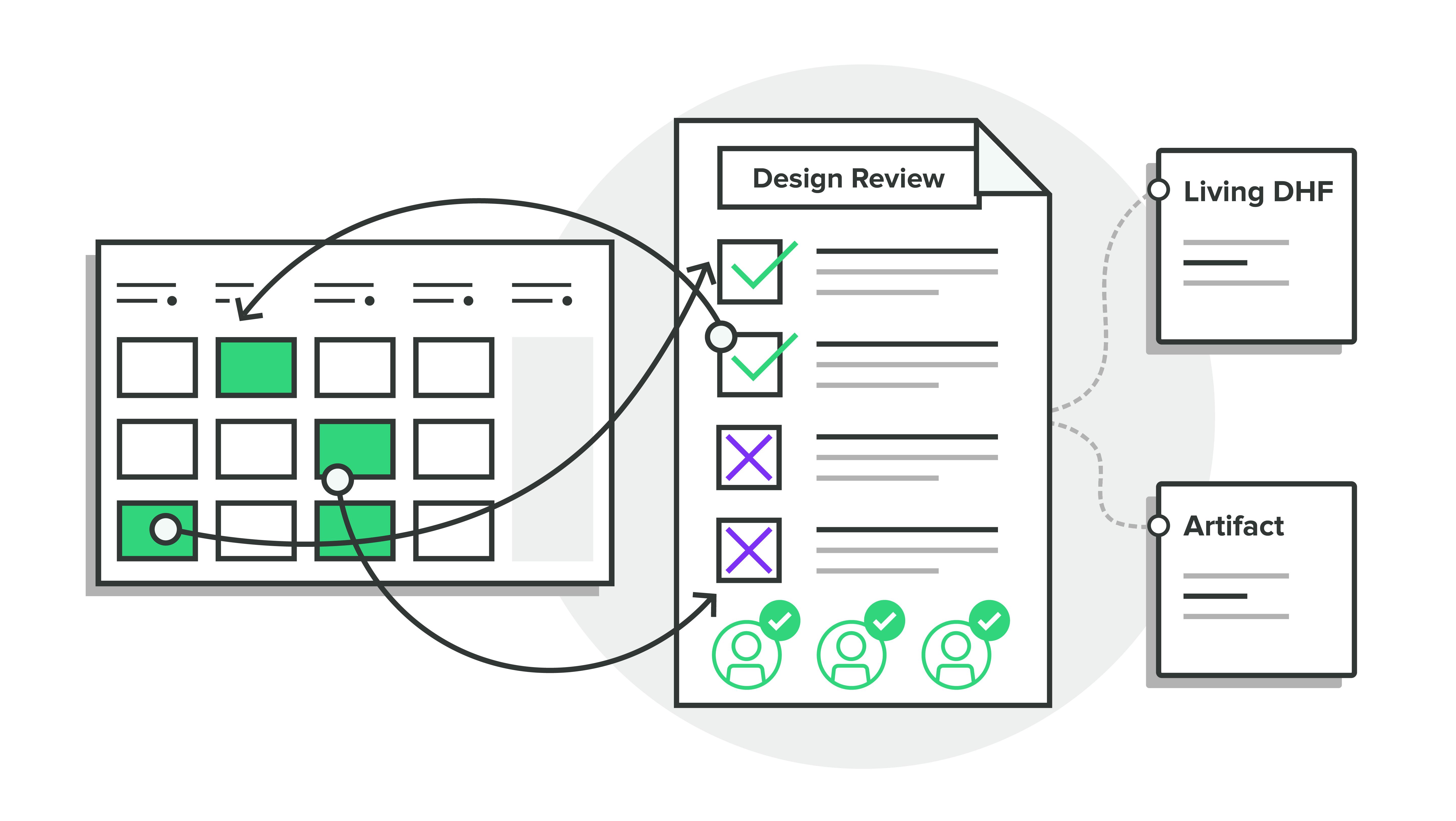
5. Partner with medical device industry experts
The medical device industry is experiencing a tsunami of regulatory changes in response to the emergence of new technologies. Regulatory bodies and MedTech companies are replacing previous best practices with more efficient approaches and methodologies. MedTech companies can’t afford to not pay attention to these changes.
Do: Choose a partner with a proven track record of success
In addition to staying abreast of regulatory changes that may apply to your medical device, it’s just as important to stay current on the best practices for your pre- and post-market quality activities. When choosing a QMS solution, look for a partner with a proven track record of success in bringing a medical device to market.
Choosing a trusted partner to serve as an extension of your team can position your company on a trajectory for success. This important advisory role can help you navigate through the winding roads of the rapidly changing medical device industry.
There’s a lot to learn as a medical device manufacturer. While there are any number of QMS providers that can offer the essential tools you need for a functioning QMS, a trusted partner with experience in the commercialization, development, and manufacturing of medical devices is an invaluable component of a QMS solution.
Leverage a QMS partner that has done it over 1,000 times before.
Don’t: Underestimate the value of staying ahead of Regulatory changes
A partnership with a medical device QMS software provider comes with endless benefits. These trusted business relationships help teams navigate quality processes within their QMS software, as well as provide insight into changes that occur in the regulatory landscape of the industry.
Some companies come into this industry with little to no experience with medical devices and the accompanying regulations. Some may understand the basic requirements needed to bring their medical device to market, but that may be the extent of their regulatory knowledge. The many nuances of medical device regulations can be foreign and difficult to navigate even for an experienced manufacturer.
The ongoing success of a medical device company hinges on their ability to understand and follow current regulations, as well as stay ahead and prepare for regulatory changes. An industry-specific QMS provider can offer companies specialized expertise to assure compliance amidst the ever-changing medical device regulatory environment.
Greenlight Guru is more than just a QMS software for medical devices. Our purpose-built solution also includes invaluable QA/RA expert services offered through our in-house Guru team. These industry experts act as an extension to a company’s team with around-the-clock service and guidance based on decades of experience with successfully developing and manufacturing medical devices.
And for those who want to learn at their own pace, Greenlight Guru Academy offers comprehensive training for medical device professionals at any stage in their career. With over 200 pieces of free training content and 16 professional certifications—all taught by MedTech industry veterans—Academy members have everything they need to stay on top of an ever-changing industry.
Choose the best QMS for your medical device
When it comes to managing the quality of your medical device, you have to consider a number of factors, such as cost, time to value, and whether or not the software is purpose-built for your needs.
Looking for an all-in-one QMS solution to advance the success of your in-market devices and integrate your quality processes with product development efforts? Get your free demo of Greenlight Guru now →
Looking for an all-in-one QMS solution to advance the success of your in-market devices and integrates your quality processes with product development efforts? Click here to take a quick tour of Greenlight Guru's Medical Device QMS software →
Etienne Nichols is the Head of Industry Insights & Education at Greenlight Guru. As a Mechanical Engineer and Medical Device Guru, he specializes in simplifying complex ideas, teaching system integration, and connecting industry leaders. While hosting the Global Medical Device Podcast, Etienne has led over 200...
Related Posts
Best QMS Software: Ultimate Guide to Comparing Quality Management System Solutions
EU MDR - 9 Top Questions Answered (European MDR)
5 Elements that Must Connect to Your Design Controls for an Audit-Proof QMS
Get your free eBook
5 Dos and Don'ts when Choosing a QMS Solution for your Medical Device Company
%205%20dos%20and%20donts%20when%20choosing%20a%20QMS%20solution.png?width=250&height=324&name=(cover)%205%20dos%20and%20donts%20when%20choosing%20a%20QMS%20solution.png)
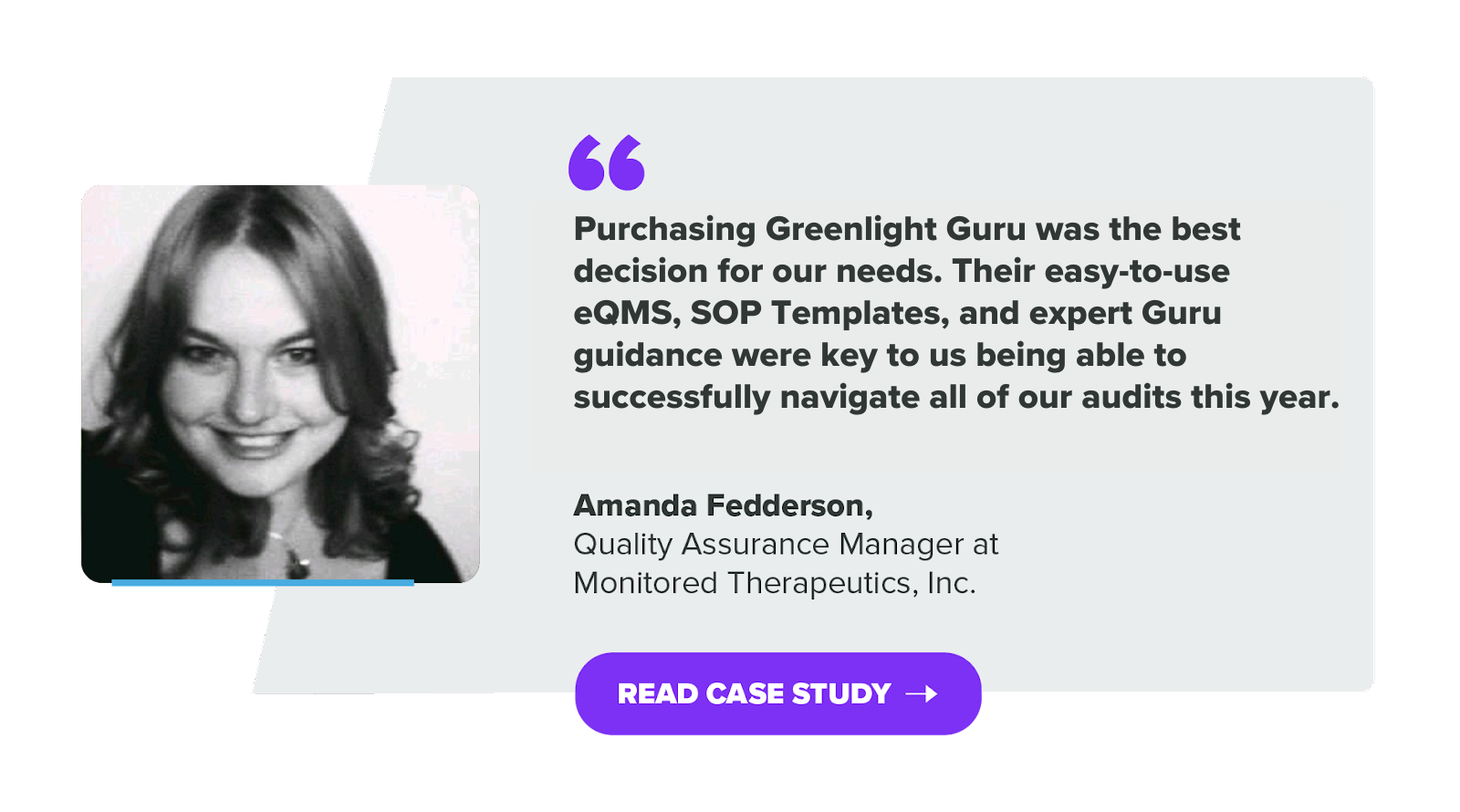


.png?width=1199&name=ROI_Slide-In-02%20(1).png)

